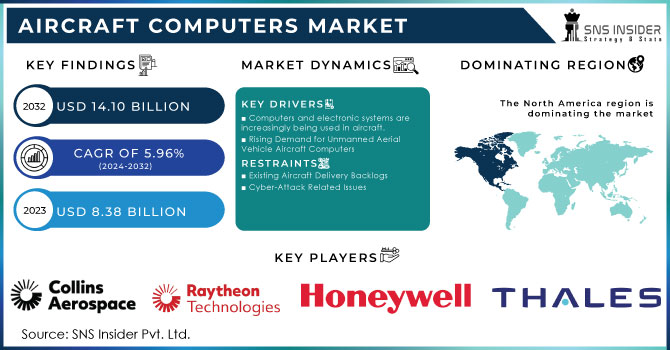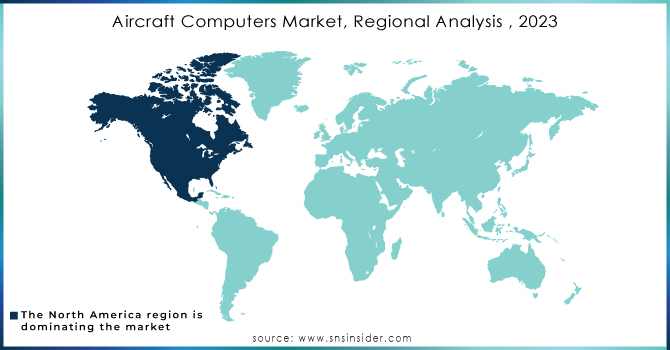Aircraft Computers Market Report Scope & Overview:

To get more information on Aircraft Computers Market - Request Free Sample Report
The Aircraft Computers Market Size was valued at USD 8.38 billion in 2023 and is expected to reach USD 14.10 Billion by 2032 with an emerging CAGR of 5.96% over the forecast period 2024-2032.
Aircraft computers are devices that are used to perform computations on various air travelling equipment (aircrafts). Computers are integrated into aircraft to reduce the burden on pilots and to assure the safety of passengers. Computers are used in aeroplanes for a variety of applications, including flight control and display, monitoring and regulating flight functions, recording and processing flight activities, providing communication and navigation, and providing passenger entertainment. Similarly, auto-pilot mode is now available thanks to aircraft computers.
In the aviation business, aircraft computers are used to execute a variety of critical activities such as designing the aircraft, managing the engine and utilities, and many more. Aircraft computers, in particular, are employed in the integration of critical features of military aircraft.
Because the aircraft computers conduct critical operations, they are regarded as the aircraft's neutral and centre. These computers are in charge of critical activities such as takeoff, cruise, descent, and others. The effective flight management systems provide comfort to the pilot and improve the flight experience.
MARKET DYNAMICS
KEY DRIVERS:
-
Computers and electronic systems are increasingly being used in aircraft.
-
Rising Demand for Unmanned Aerial Vehicle Aircraft Computers
RESTRAINTS
-
Existing Aircraft Delivery Backlogs
-
Cyber-Attack Related Issues
CHALLENGES
-
The key difficulty is the malfunctioning of software solutions during flight, as well as the efficient operation of the engine and utilities.
-
The growing number of aircraft applications and deliveries around the world are posing a significant challenge to the expansion of the aviation computer market.
OPPORTUNITIES
-
Demand for Aircraft Computers in Unmanned Aerial Vehicles is Growing
IMPACT OF COVID-19
Due to the nature of COVID-19, industrial production worldwide has been disrupted due to announced closures and government restrictions on public gatherings.
The demand for aviation computers is being affected by the withdrawal of large numbers of aircraft around the world to curb the spread of the virus.
Travel restrictions could lead to cancellation of aircraft order in the future which may affect aircraft manufacturing companies as well as aircraft computers.
The need for spare parts is also low because there is no need as many airlines are closed due to the COVID-19 epidemic.
Key companies in the affected aviation industry worldwide include Qatar Airways, Emirates, China Eastern Airlines, Lufthansa, Boeing, Airbus, American Airlines Group Inc., and Delta Air Lines. For example, Qatar Airways suspended all flights to and from Italy which was one of the countries most affected by the COVID-19 epidemic.
Based on the platform, the computer aviation market is divided into a constant rotating wing, as well as a UAV. The segmented aircraft with fixed wings is expected to lead the market during the forecast period, due to the growing demand for commercial and military aircraft. The market for commercial fixed aircraft is expected to grow due to the growth in the number of passengers.
Based on end user, the flying computer market is divided into OEM and aftermarket. The OEM market is expected to grow in the CAGR during the forecast period. The high growth could be attributed to modern aviation systems and the adoption of aircraft computing systems that will be integrated into an advanced aircraft from the production line.
Based on the model, the aircraft computer market is divided into flight controls, engine controls, flight control computers, machine computers, and service controls. The flight control segment is expected to grow at a high rate during the forecast period. Aircraft control computers assist the pilot in controlling the altitude, speed, and orientation of the aircraft.
The expansion of the aircraft computers market is being driven by an increase in the number of aircraft orders as a result of increased air passenger traffic and political conflicts between countries. Additionally, increased tourism around the world and lower fuel prices boosted demand for new planes. Such an increase in aircraft deliveries will necessitate the purchase of new hardware, such as aircraft computers. As a result, a rise in aircraft orders will drive demand for aircraft computers.
Value Chain Analysis
The growth of the computer aviation market is greatly influenced by the increasing use of computers in the aerospace industry and the growing demand for electronic systems and modernization of aviation vessels. Leading market players bring new developments to the industry as well. For example, one of the leading market players, Honeywell has introduced a new integrated system used in urban air vehicles called “fly-by-wire” that ensures potential failures that control failure and turn the plane offline. The need for stable aviation is high throughout the industry and this invention has given impetus, especially to unmanned vehicles.
Important features such as advanced computers and monitoring controls and other engine functionality are performed by engine controls performed by advanced computers in the industry. Similarly, advanced computers are used in resource management due to the growing need for fuel management, centralized care, and display management. As the demand for these key features is high the demand for aviation computer market is expected to grow during the forecast period.
KEY MARKET SEGMENTATION
By Platform
-
Fixed Wing Aircraft
-
Rotary Wing Aircraft
By Component
-
Hardware
-
Software
By Type
-
Flight Controls
-
Engine Controls
-
Utility Controls
-
Flight Management Computers
-
Mission Computers
By End-User
-
OEM
-
Aftermarket
REGIONAL ANALYSIS
North America, Europe, Asia Pacific, and the Rest of the World comprise the Global Aircraft Computers Market. North America and Europe control the Global Market with the greatest market stake and are expected to rise significantly and dominate the Global Aircraft Computers Market throughout the forecast period.

Need any customization research on Aircraft Computers Market - Enquiry Now
REGIONAL COVERAGE:
-
North America
-
USA
-
Canada
-
Mexico
-
-
Europe
-
Germany
-
UK
-
France
-
Italy
-
Spain
-
The Netherlands
-
Rest of Europe
-
-
Asia-Pacific
-
Japan
-
south Korea
-
China
-
India
-
Australia
-
Rest of Asia-Pacific
-
-
The Middle East & Africa
-
Israel
-
UAE
-
South Africa
-
Rest of Middle East & Africa
-
-
Latin America
-
Brazil
-
Argentina
-
Rest of Latin America
-
KEY PLAYERS
The Major Players are Collins Aerospace, Raytheon Technologies Corporation, Thales Group, Honeywell International Inc, Safran, BAE Systems., Cobham Limited, Transdigm Group Inc, Saab AB, Curtiss-Wright Corporation, and other players
| Report Attributes | Details |
|---|---|
| Market Size in 2023 | US$ 8.38 Billion |
| Market Size by 2032 | US$ 14.10 Billion |
| CAGR | CAGR of 5.96% From 2024 to 2032 |
| Base Year | 2023 |
| Forecast Period | 2024-2032 |
| Historical Data | 2020-2022 |
| Report Scope & Coverage | Market Size, Segments Analysis, Competitive Landscape, Regional Analysis, DROC & SWOT Analysis, Forecast Outlook |
| Key Segments | • By Platform (Fixed Wing Aircraft, Rotary Wing Aircraft, and Unmanned Aerial Vehicles (UAVs)) • By Component (Hardware, and Software) • By Type (Flight Controls, Engine Controls, Utility Controls, Flight Management Computers, and Mission Computers) • By End User (OEM, and Aftermarket) |
| Regional Analysis/Coverage | North America (USA, Canada, Mexico), Europe (Germany, UK, France, Italy, Spain, Netherlands, Rest of Europe), Asia-Pacific (Japan, South Korea, China, India, Australia, Rest of Asia-Pacific), The Middle East & Africa (Israel, UAE, South Africa, Rest of Middle East & Africa), Latin America (Brazil, Argentina, Rest of Latin America) |
| Company Profiles | Collins Aerospace, Raytheon Technologies Corporation, Thales Group, Honeywell International Inc, Safran, BAE Systems., Cobham Limited, Transdigm Group Inc, Saab AB, Curtiss-Wright Corporation, and other players. |
| DRIVERS | • Computers and electronic systems are increasingly being used in aircraft. • Rising Demand for Unmanned Aerial Vehicle Aircraft Computers |
| RESTRAINTS | • Existing Aircraft Delivery Backlogs • Cyber-Attack Related Issues |

